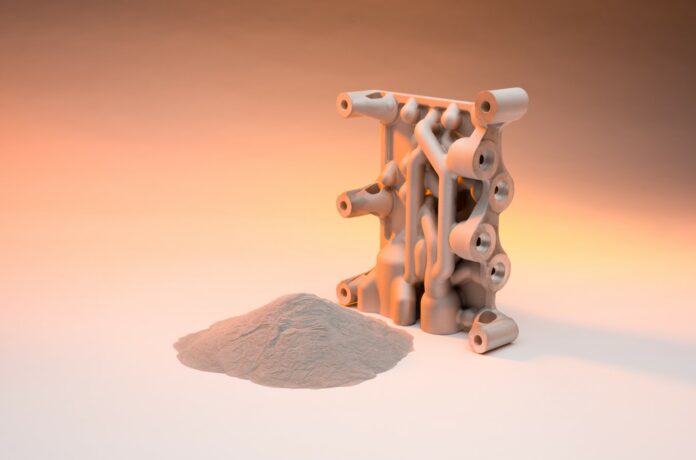By definition, an alloy is a mixture of two or more metals or of a base metal with non-metallic additions. By integrating various elements into a pure metal’s lattice structure, materials properties can be enhanced far beyond those of the base element. Alloys such as bronze (e.g., copper with additions of tin) and steel (e.g., iron with additions of carbon) have been used by humanity for thousands of years to increase the mechanical performance, or strength, of structural parts and tools. In the AM industry, many AM end-users do not realize the tremendous potential of high-strength alternatives to standard materials such as AlSi10Mg and Ti6Al4V. In what has become our traditional annual catch-up, Dr. Ulrich Schmidt and Dr. Moritz Roscher, respectively Global Head of Technical Marketing and Head of Additive Manufacturing Alloys of the Business Line Functional Applications at ECKART GmbH, share that the company broadens its portfolio of high-strength Al- and Ti-based alloys for Additive Manufacturing.
As a reminder, ECKART GmbH is a division of speciality chemicals group ALTANA headquartered in Germany. After an acquisition of UK-based Aluminium Materials Technologies Ltd. (AMT), the company has positioned itself in the AM market, as the developer and provider of A20XTM, a lightweight aluminum-based powder derived from the aerospace-approved (MMPDS) A205 alloy.
As one of the most widespread AM processes, it made sense for material producers to design high-strength aluminum alloys that are compatible with Laser Powder Bed Fusion (LPBF). The problem is, the susceptibility of conventional high-strength aluminium alloys for hot cracking and a general poor processability have often made the processing of high-strength aluminum alloys by L-PBF difficult.
ECKART GmbH addressed these issues with its aerospace-approved material. A20XTM unique chemical composition contains ceramic TiB2 particles which modify the solidification mechanism, resulting in fully equiaxed and fine-grained microstructures. The material is not susceptible to solidification cracking and can be processed on any commercial LPBF machine.
The company is now pushing the capacities of its material to allow processing by other AM technologies. “Currently, the main driver for the use of A20X is LPBF. However, in feasibility studies, A20X was successfully used in laser-based DED. We are actively pushing A20X in DED applications as we are convinced that the properties are also a perfect fit for this field of use,” the experts say.
Furthermore, as costs and recyclability remain key considerations for AM users who are scrutinizing any means by which they can alleviate the final cost of the 3D printed part and make the most of each AM equipment, it is important for material producers to ensure that the properties of their material make it possible to reuse the leftover material at the end of the production.
Indeed, as you may know, there are often two types of powder that are left in the powder bed at the end of a manufacturing process: one that is affected by the build process and includes powder that was partially-melted or heated during the process but was not fused in the fabricated part and another type of powder recovered after a build.
Schmidt and Roscher confirm that the “A20X powder is reusable, with the provision that critical parameters like oxygen content or removal of spatters are considered. There is no general guideline as the complete individual printing process needs to be taken into account. Scientific projects aiming to use excess A20X powder show that there are ways, e.g. the FAST process, that enable to recycle the material successfully.”
New developments at ECKART GmbH
“If in the field of Aluminum alloys, Eckart’s strength is the well-known A20X alloy – a unique material with aerospace approval. At Formnext, Eckart will show for the first time high strength Titanium alloys like Ti-5-5-5-3, Ti-6-2-4-2, or Ti-6-2-4-6, which are standing out by their mechanical performance,” Schmidt and Roscher enthuse.
Titanium alloys often need complex casting and thermomechanical processing to perform the high strength required for some critical applications. Thanks to its capabilities, L-PBF remains one of the technologies that can enable the production of these much-needed strong and thermally stable 3D printed parts in commercial titanium alloys.
Given its decades of experience in the manufacturing of pure, spherical and nodular aluminum powders, zinc and copper-based metal powders, as well as various titanium alloys, I trust ECKART has built on this experience to deliver a material worthy of the AM industry.
From a strict business standpoint, despite a challenging market environment marked by harsh price fluctuations, supply chain and raw material shortages globally, the industry insiders report that the metal powder segments profit from the above average growth of the AM industry. “To keep pace with the growing markets, Eckart is already considering capacity expansion for its AM powders,” they add.
The next rendez-vous?
We can’t wait for our experts to share more about the development and applications of its new high strength alloys for AM. The next rendez-vous is definitely the one of Formnext 2023, where the company will be showcasing its latest metal powder portfolio and customizing capabilities in Hall 12.0, booth A101.
“On the booth we will be showcasing an automotive racing part from a formula student racer car. This part was deliberately LPBF printed with A20X powder due to the exceptional mechanical properties which enable the use as critical component, specifically a wheel carrier. Face-to-face meetings and inspiring talks with industry experts will help us to continuously improve our services and offerings”, Schmidt and Roscher conclude.
This content was first published in the September/October edition of 3D ADEPT Mag






